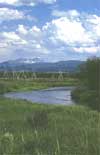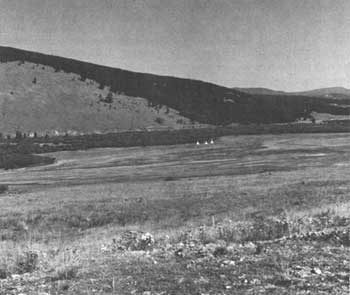





Survey of Historic Sites and Buildings
 |
BIG HOLE NATIONAL BATTLEFIELD Montana |
 |
| ||
This national battlefield memorializes the courage of the Nez Perce Indians and the soldiers who fought one of the battles of the Nez Perce War at the site in 1877. After crossing the Lolo Trail in their flight from Idaho, believing their tribulations over, the nontreaty Nez Perces proceeded southward along the Bitterroot Valley. Reaching the Big Hole prairie on August 7, they camped near the north fork of the Big Hole River.
On August 8 Col. John Gibbon, accompanied by 17 officers and 146 enlisted men of the 7th Infantry from Fort Ellis, Missoula, and Shaw, Mont., and a group of civilian volunteers located the camp. That evening the troops, undetected, took a position directly across the river from it. At dawn, the tepees clearly in sight, they moved down into the willow-lined river bottom. An Indian on his way to check the horseherd, which the troops had already passed, approached the left of the line. When one of the men fired and killed him, the assault began. The troops plunged across the river to the camp. Most of the Indians, who had been sleeping, fled in panic. Some ran directly into the path of the soldiers, who fired at anyone in sight—man, woman, or child. Before the troops could destroy the camp, the Indians, infuriated at the loss of women and children, began a counterattack.
 |
| Indian village site, Big Hole National Battlefield. The tepees marking the site were erected for the visitor center ground-breaking ceremonies in August 1967, but have since been removed. (photo Bill Keller, National Park Service) |
The soldiers retreated to a wooded area across the river from the upper end of the camp. They took shelter on a bluff behind logs and trees and in hastily dug rifle pits. At this point, some of the Indians besieged the troops, while others returned to the camp to pack supplies and equipment. The main body departed, continuing their retreat, while a small group of warriors maintained the siege until the next morning.
Gibbon was unable to give pursuit because of his heavy losses—29 dead and 40 wounded—and lack of supplies. His men had slain 89 Indians, including probably 50 women and children, and wounded many more. The loss of warriors, lodges, and supplies seriously handicapped the embittered Nez Perces, but they pushed on southward and eastward across Yellowstone National Park. Continually brushing aside or eluding the military forces pursuing them, they then turned northward en route to a hoped-for refuge in Canada. But less than 2 months elapsed before they met a heart-rending defeat at the Battle of Bear Paw Mountains, Mont.
Big Hole National Battlefield embraces the siege area, the site of the Indian village, a monument to the Nez Perce Chief Joseph, the place where the Indians captured a howitzer, and the area across the Big Hole River where the Nez Perces besieged the troops. The natural setting has changed little since 1877. Traces of rifle pits may still be seen. The visitor center museum displays exhibits of the battle, including the captured howitzer and a battle diorama. A self-guiding trail leads through the siege area to the howitzer-capture site.
 |
 |
http://www.cr.nps.gov/history/online_books/soldier-brave/sitea17.htm
Last Updated: 19-Aug-2005